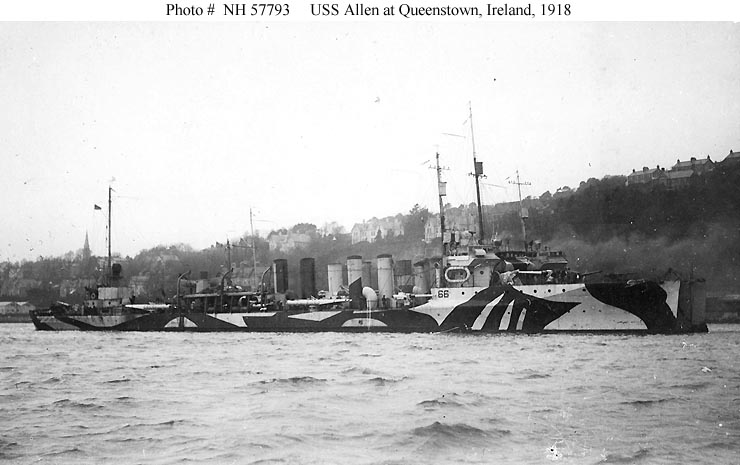USS Allen (DD-66)
Reviewed by Devin Poore, July 2023
USS Allen launched in 1916, then commissioned in January of 1917. By 14 June of 1917, she escorted one of the first convoys bound for Europe, after which she joined the U.S. destroyer squadron based out of Queenstown, Ireland. She spent the remainder of the war at Queenstown, performing U-boat patrols, and escorting east-bound convoys on the final leg of their journey.
Between the wars, Allen spent her time patrolling the East Coast of the U.S., and as a training ship. She also spent the years of 1922-1925 and 1928-1940 out of commission, in reserve. Reactivated in August of 1940, USS Allen transferred to Pearl Harbor, and was present for the Japanese attack on December 7th. Her gunners claimed to assist in the downing of three attacking aircraft, but it doesn't appear as if those kills were ever verified.
Allen spent the entirety of the war based out of Pearl Harbor, both on anti-submarine patrol, and as a training ship. Her armament was upgraded various times throughout the war. When she was put out of commission for the final time in October of 1945, she was the longest serving destroyer in the U.S. Navy.

Various holes and divots dot the deck, which are mounting points for the ship's stacks, guns, and vents. These will help greatly with placing those items, both in alignment and giving added stability with the peg-in-hole approach.
The full size USS Allen is listed as measuring 315' and 3". That converts to 5.4" (137.3mm) in 1/700. The kit hull measures precisely at 5.4", or 137.28mm, which is perfect.







The rest of the parts come on resin blocks/runners. A single runner holds the four 4" guns, which get further detailed with photoetch. Another block has the ship's boats and searchlight tubs. The boats are lightly detailed but the seats and other items that are there are quite sharp and clean. The four, triple torpedo tubes and four stacks make up another block of castings; detail on the tube mounts is sharp, and the stacks have well rendered banding and are nicely hollow. The remainder of the parts come on three casting blocks, and make up the bulk of the fine details. Life rafts have ample floor detail, while the cowl vents are just hollow enough that in this scale they'll more than look the part with a light pin-wash in the opening. There are also small gun mounts (the Sampson class carried two 1-pound mounts). The balance of the parts are super-tiny bits that look to be compasses, pelorus, voice tubes, and other deck components to detail out the bridge and other locations. I can not find a single air bubble or short-cast part in the entire kit.










The brass is extremely thin, just over .1mm (.004") thick, yet feels to have a bit of rigidity to it, which should make it easier and more forgiving to work with. This is a welcome improvement over the older, softer brass that Combrig once used.




Assembly is covered on only two pages, exploded view. Specific assembly steps are called out for the boat davits, gun mounts, the bridge and after superstructure deck, and a few other small assemblies. The remaining components are shown with leader lines indicating where they are to be placed on the deck. Be sure to continually reference both sides of the instruction sheet, as sub-assembly guides may be shown on one side, while their placement is covered on the opposite sheet. The plan and profile cover page shows enough rigging to figure out what's going on, but it may be simplified. One omission is the lack of any sort of paint callouts. Allen wore a dramatic camouflage scheme, but no pattern or colors are shown at all. The builder will have to do some research into the pattern and colors on this one.




Combrig kits are tricky to find currently, for probably obvious reasons. Freetime Hobbies does have stock of some of the U.S. WWI destroyer kits, but not Allen. The kits are in the $50 price range, so the recommendation would be to keep an eye on their site for future stock.
Highly recommended. Thank you to Combrig for the review sample.


© ModelWarships.com
